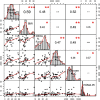Genomic Variants Associated with Resistance to High Fat Diet Induced Obesity in a Primate Model
- PMID: 27811965
- PMCID: PMC5095882
- DOI: 10.1038/srep36123
Genomic Variants Associated with Resistance to High Fat Diet Induced Obesity in a Primate Model
Abstract
Maternal obesity contributes to an increased risk of lifelong morbidity and mortality for both the mother and her offspring. In order to better understand the molecular mechanisms underlying these risks, we previously established and extensively characterized a primate model in Macaca fuscata (Japanese macaque). In prior studies we have demonstrated that a high fat, caloric dense maternal diet structures the offspring's epigenome, metabolome, and intestinal microbiome. During the course of this work we have consistently observed that a 36% fat diet leads to obesity in the majority, but not all, of exposed dams. In the current study, we sought to identify the genomic loci rendering resistance to obesity despite chronic consumption of a high fat diet in macaque dams. Through extensive phenotyping together with exon capture array and targeted resequencing, we identified three novel single nucleotide polymorphisms (SNPs), two in apolipoprotein B (APOB) and one in phospholipase A2 (PLA2G4A) that significantly associated with persistent weight stability and insulin sensitivity in lean macaques. By application of explicit orthogonal modeling (NOIA), we estimated the polygenic and interactive nature of these loci against multiple metabolic traits and their measures (i.e., serum LDL levels) which collectively render an obesity resistant phenotype in our adult female dams.
Figures



References
Publication types
MeSH terms
Substances
Grants and funding
LinkOut - more resources
Full Text Sources
Other Literature Sources
Medical
Miscellaneous

